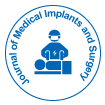Orthopedic Robotics: Enhancing Surgical Precision and Improving Patient Outcomes
Received: 01-Jan-2024 / Manuscript No. jmis-25-160835 / Editor assigned: 03-Jan-2024 / PreQC No. jmis-25-160835 (PQ) / Reviewed: 17-Jan-2024 / QC No. jmis-25-160835 / Revised: 22-Jan-2024 / Manuscript No. jmis-25-160835 (R) / Published Date: 29-Jan-2024 DOI: 10.4172/jmis.1000209
Introduction
Methodology
To assess the current landscape of orthopedic robotics, a systematic review of recent studies, clinical trials, and technological advancements in robotic-assisted orthopedic surgeries was conducted. The following methodology was used:- Literature review: A thorough review of existing literature was performed using electronic databases such as PubMed, Google Scholar, and Science Direct [6]. Keywords such as orthopedic robotics, robotic-assisted surgery, joint replacement, spinal surgery robotics, and AI in orthopedics were used to identify relevant articles published in the past five years [7]. The focus was on peer-reviewed studies, clinical trials, and technical reports.
- Analysis: The data from the studies were analyzed to identify trends and patterns in the outcomes of robotic-assisted surgeries [8, 9]. This included comparing robotic systems' effectiveness in various orthopedic applications, assessing their clinical impact, and discussing patient satisfaction and cost-effectiveness. Expert opinions interviews with orthopedic surgeons and robotic system manufacturers were conducted to gather insights into the practical implementation of robotic technologies, challenges faced in the clinical setting, and future trends in robotic surgery [10].
Conclusion
Orthopedic robotics has emerged as a transformative force in modern surgery, offering enhanced precision, improved surgical outcomes, and significant benefits for patients. Robotic-assisted systems, integrated with advanced imaging technologies and artificial intelligence, enable orthopedic surgeons to perform procedures with greater accuracy, particularly in joint replacements, spinal surgeries, and complex fracture repairs. The ability to create personalized surgical plans based on real-time data has improved the overall effectiveness of surgeries, leading to quicker recovery times, reduced complication rates, and better long-term results. Despite the promising advantages, challenges such as high initial costs, the need for specialized training, and the integration of robotic systems into existing surgical workflows remain. However, with continuous advancements in robotic technology, these barriers are expected to decrease over time, making robotic-assisted orthopedic surgeries more accessible and cost-effective. Additionally, the growing role of artificial intelligence and machine learning in refining surgical techniques and decision-making further enhances the potential for orthopedic robotics to revolutionize patient care. In the future, the expansion of robotic-assisted surgery in orthopedics will likely lead to even greater innovations, such as minimally invasive procedures, improved patient-tailored treatments, and the integration of augmented reality (AR) for real-time surgical navigation. The continued development and refinement of robotic technologies, along with the increasing adoption of AI and machine learning, promise to further elevate the precision and safety of orthopedic surgeries, ultimately transforming the way orthopedic conditions are treated worldwide.Acknowledgement
NoneConflict of Interest
NoneReference
- Jones J, Antony AK (2019)direct to implant pre-pectoral breast reconstruction. Gland surg 8: 53-60.
- Sinnott J, Persing S, Pronovost M (2018)Impact of Post mastectomy Radiation Therapy in Prepectoral Versus Subpectoral Implant-Based Breast Reconstruction.Ann Surg Oncol 25: 2899-2908.
- Potter S, Conroy EJ, Cutress RI (2019)Short-term safety outcomes of mastectomy and immediate implant-based breast reconstruction with and without mesh (iBRA). Lancet Oncol 20: 254-266.
- Jeevan R, Cromwell DA, Browne JP (2014)Findings of a national comparative audit of mastectomy and breast reconstruction surgery in England. Plast Reconstr Aesthet Surg 67: 1333-1344.
- Casella D, Calabrese C, Bianchi S (2015)Subcutaneous Tissue Expander Placement with Synthetic Titanium-Coated Mesh in Breast Reconstruction.Plast Recontr Surg Glob Open 3: 577.
- Vidya R, Masila J, Cawthorn S (2017)Evaluation of the effectiveness of the prepectoral breast reconstruction with Braxon dermal matrix: First multicenter European report on 100 cases. Breast J 23: 670-676.
- Hansson E, Edvinsson Ach, Elander A (2021)First-year complications after immediate breast reconstruction with a biological and a synthetic mesh in the same patient. J Surg Oncol 123: 80-88.
- Thorarinson A, Frojd V, Kolby L (2017)Patient determinants as independent risk factors for postoperative complications of breast reconstruction.Gland Surg 6: 355-367.
- Srinivasa D, Holland M, Sbitany H (2019)Optimizing perioperative strategies to maximize success with prepectoral breast reconstruction.Gland Surg 8: 19-26.
- Chatterjee A, Nahabedian MY, Gabriel A (2018)Early assessment of post-surgical outcomes with prepectoral breast reconstruction. J Surg Oncol 117: 1119-1130.
Indexed at, Google Scholar, Crossref
Indexed at, Google Scholar, Crossref
Indexed at, Google Scholar, Crossref
Indexed at, Google Scholar, Crossref
Indexed at, Google Scholar, Crossref
Indexed at, Google Scholar, Crossref
Indexed at, Google Scholar, Crossref
Indexed at, Google Scholar, Crossref
Indexed at, Google Scholar, Crossref
Share This Article
Recommended Conferences
42nd Global Conference on Nursing Care & Patient Safety
Toronto, CanadaRecommended Journals
Open Access Journals
Article Tools
Article Usage
- Total views: 331
- [From(publication date): 0-0 - Apr 28, 2025]
- Breakdown by view type
- HTML page views: 160
- PDF downloads: 171
